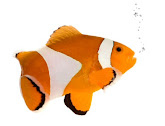Sexual dimorphism is the systematic difference in form between individuals of different sex in the same species. Examples include size, color, and the presence or absence of parts of the body used in courtship displays or fights, such as ornamental feathers, horns, antlers or tusks.
Dimorphism comes from two Greek words, di meaning two and morph meaning form. Thus, sexual dimorphism basically refers to two forms of sex, male and female.
Examples
Female Triplewart seadevil, an anglerfish, with male attached near vent (arrow)
Some species of anglerfish also display extreme sexual dimorphism. Females are typical anglerfish, while males are tiny rudimentary creatures with no digestive systems. The males must find a female and fuse with her – he then lives parasitically, becoming little more than a sperm-producing body. A similar situation is found in the Zeus water bug Phoreticovelia disparata where the female has a glandular area on her back that can serve to feed a male that clings to her (though males can survive away from females, they generally are not free-living).
Psychological and behavioral differentiation
Sex steroid-induced differentiation of adult reproductive and other behavior has been demonstrated experimentally in many animals.
Evolution of sexual dimorphism
Handicap principle
The handicap principle is the proposed evolutionary force that gives males of some species traits that at first glance seem to place the organism at a disadvantage.
For example, the bright colouration of male game birds makes them highly visible targets for predators, while the drab females are better camouflaged. Other examples are bird of paradise and lyrebird, whose males have such large plumes that their flight is inhibited. Strong smells, loud cries and singing can also attract predators.
The answer that has been suggested to this apparent paradox is that, at a biological level, the reproductive success of an organism is often more important than duration of life. This is particularly apparent in the case of game birds: a male Common Pheasant in the wild often lives no more than 10 months, with females living twice as long. However, a male pheasant's ability to reproduce depends not on how long he lives but whether females will select him to be their mate.
A brightly coloured and heavily plumed male presumably demonstrates to the female that he is fit in evolutionary terms –
Sexaul dimorphism of the polygamis Northern elephant seal
he has been able to survive in spite of impediments and must therefore be a good choice to father her chicks (especially her daughters, who will have his "fit" genes, but will not be hampered by male plumage). This explanation was first proposed by Amotz Zahavi.
Development of such characters could not at first be explained in terms of simple natural selection. In 1871 Charles Darwin advanced the theory of sexual selection, which related sexual dimorphism with sexual selection.
Polygamy
Comparison of sexual dimorphism in birds and their mating habits shows that the time spent in search for mates, staking territories and mating competes with the demands of taking care of young. For birds and in general, it can be stated that the stronger the dimorphism in a species, the more likely is it to be polygamous and the less is the task of caring for offspring shared among the sexes. This theory is developed by R. L. Trivers' in the parental investment theory. It applies to all ecology.



